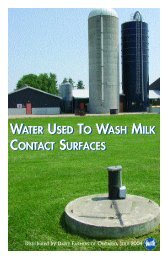Canadian Quality Milk On-Farm Food Safety Program - Centre ...
Canadian Quality Milk On-Farm Food Safety Program - Centre ...
Canadian Quality Milk On-Farm Food Safety Program - Centre ...
You also want an ePaper? Increase the reach of your titles
YUMPU automatically turns print PDFs into web optimized ePapers that Google loves.
<strong>Canadian</strong> <strong>Quality</strong> <strong>Milk</strong><br />
AND,<br />
c) Ensure the SOP for Shipping Cattle identifies where the multiple treatment<br />
record is; thereby, enabling employees to find the record and check it before<br />
shipping an animal.<br />
4.6.2 Standard Operating Procedures<br />
To ensure that all personnel on a farm understand and follow the same procedures<br />
when treating an animal, a general Standard Operating Procedure must be written for<br />
treating cattle. The SOP must contain enough information to ensure that someone<br />
treating animals would not cause a milk or meat hazard. The procedure must include<br />
the various mandatory Best Management Practices outlined in this chapter related to<br />
the use of livestock medicines and other chemicals.<br />
You should consider the following Best Management Practices when you develop your<br />
own SOP, but you must include the Best Management Practices that are shaded<br />
grey:<br />
Read and follow label directions to determine proper dosage and ensure livestock<br />
medicines are administered properly.<br />
Use products approved in Canada for use in dairy cattle, unless a veterinary<br />
prescription indicates otherwise. This includes only using registered pesticides.<br />
Obtain a written veterinary prescription for all treatments given extra-label.<br />
Please note: In Quebec, all medications administered to dairy animals must be accompanied<br />
by a written veterinary prescription.<br />
Mark treated animals.<br />
Record the identity of any animals carrying broken needles and record the site.<br />
Record the treatment and the appropriate withdrawal dates for both milk and meat.<br />
Record treatments for all cattle on the farm (e.g. calves, heifers, dry cattle, bulls,<br />
etc). Pesticides applied to an animal are considered treatments as well.<br />
Ensure teats are cleaned and dried when administering intramammary infusions.<br />
4.6.3 Corrective Actions<br />
To prepare for an emergency situation, you must have a written corrective action plan<br />
on how to communicate and address the situation where an animal has been<br />
administered medication or other chemicals incorrectly. The workbook contains a<br />
sample form (Record 16). See Chapter 9 for more information.<br />
You also must record whenever a problem occurs regarding treating animals and what<br />
corrective action was taken to remedy the situation. A sample form is in the Workbook<br />
(Record 17).<br />
June 2010 4—23
















